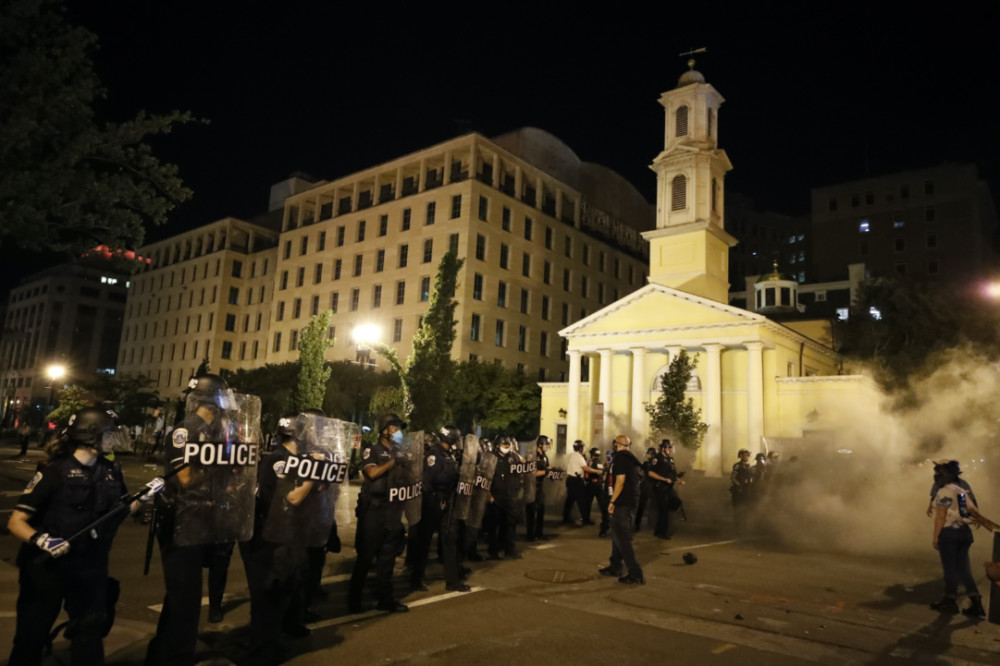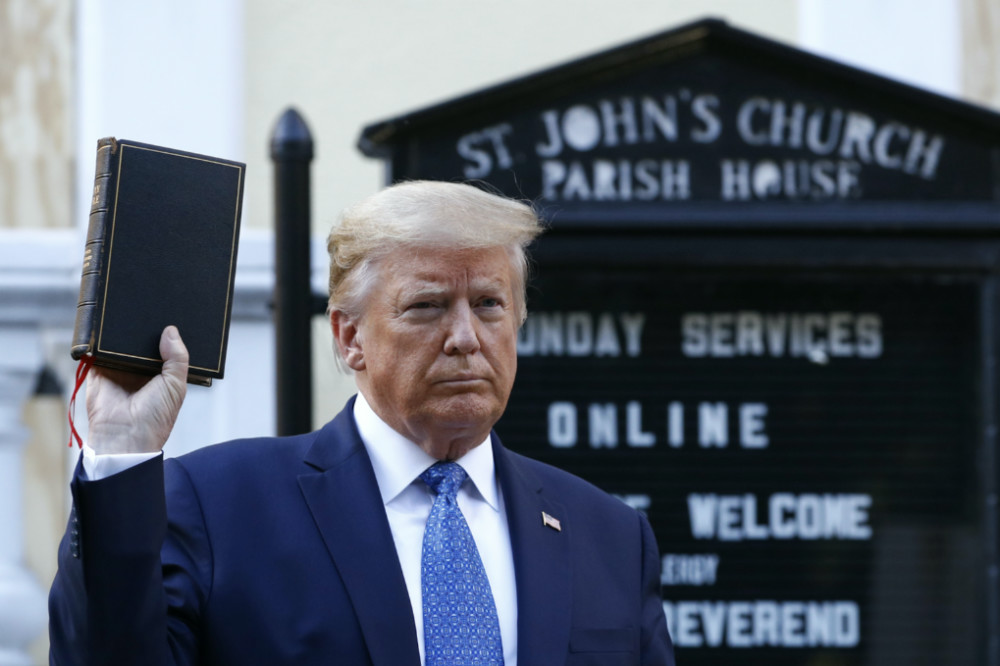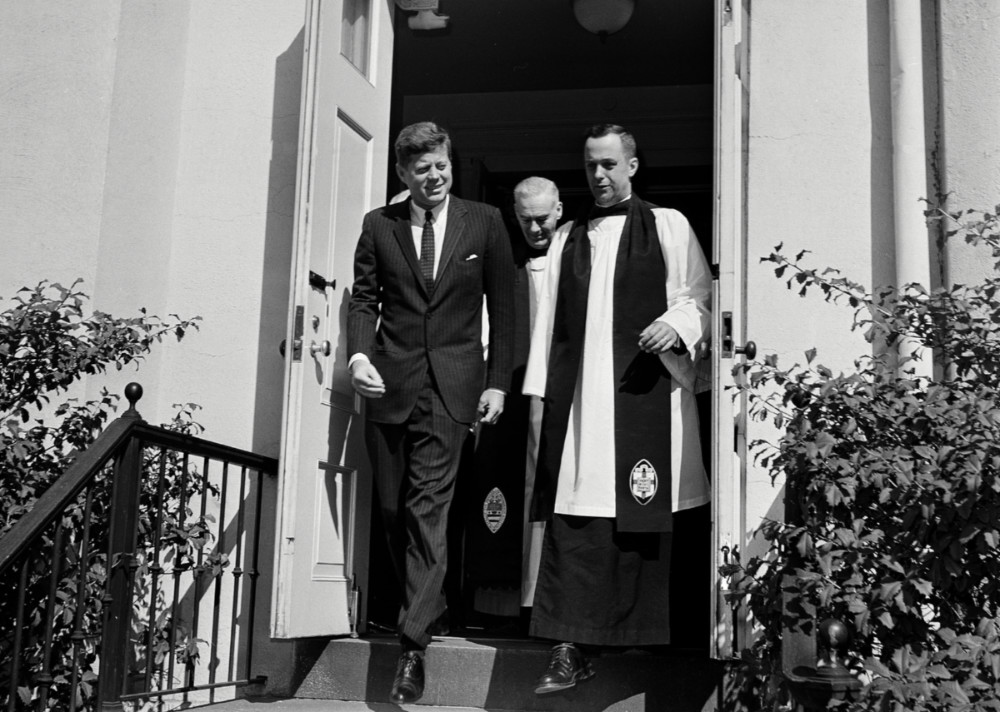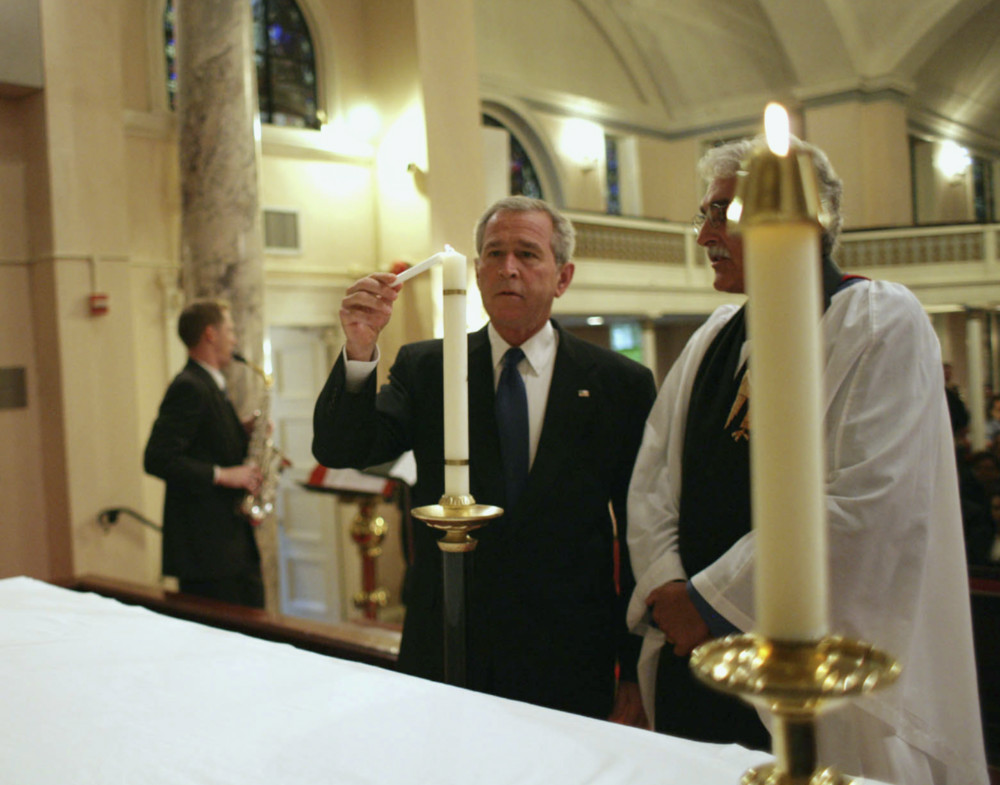
Famous in recent times as a setting for a Donald Trump photo op, ELANA SCHOR, of Associated Press, looks at the role Washington’s St John’s Episcopal Church has played in the US story…
Rev John C Harper had been rector at the historic St John’s Episcopal Church for less than a year when the 1963 March on Washington began taking shape. A lay leader in the congregation urged him to steer clear of it – but instead he embraced it.
Harper held a service the morning of the march, welcoming a diverse crowd of more than 700 people at the church across from the White House. Black Episcopal choir members sang alongside the St John’s choir, and the service ended with worshippers holding hands to sing the iconic civil rights movement song We Shall Overcome.
“The church has too long been silent on this important issue,” Harper wrote to church members that month. “Now at long last Christians like ourselves are aroused by the injustice of discrimination in any form and by any kind of segregation on the basis of a man’s color.”

In this Saturday, 30th May, file photo, police for a line near St John’s Episcopal Church as demonstrators gather to protest the death of George Floyd, near the White House in Washington. Floyd, a Black man, died after being restrained by Minneapolis police officers. St. John’s, at the epicenter of protests in Washington, has a long legacy on civil rights dating to its embrace of the 1963 March on Washington. PICTURE: AP Photo/Alex Brandon/File photo.
The summer of 1963 left a lasting legacy at the yellow-walled house of worship, consecrated in 1816 and often referred to as “the Church of the Presidents” for having hosted every leader since James Madison at least once.
Core principles such as support for equal rights, community engagement and eschewing partisan politics while not shying away from the pressing issues of the moment have guided St John’s for decades and continue to do so today, after the church once again found itself at the center of an American awakening over racial injustice following George Floyd’s killing.
“What Rev Harper did was avoid the temptation to be pulled on one side or another, but to just be a graceful place in the middle of it all, and I think that’s exactly what we were doing.”
– Rev Rob Fisher, rector at St John’s.
On the night of 31st May, the basement of St John’s parish house suffered fire damage during protests against police brutality and racism. The following day President Donald Trump staged a photo-op outside after police forcibly cleared the streets of demonstrators, putting the church’s apolitical ethos to the test.
The Rt Rev Mariann Budde, Washington’s Episcopal bishop, expressed outrage at Trump’s use of the church immediately afterward. But true to the St John’s way, it did not become a symbol of repudiation of the President in the ensuing weeks.
Instead St John’s has sought to maintain the spirit of the volunteer effort that sprouted organically the morning after the fire, when parishioners and others showed up to comfort the community – what church leaders called a “ministry of presence” in messages to parishioners.
“What Rev Harper did was avoid the temptation to be pulled on one side or another, but to just be a graceful place in the middle of it all, and I think that’s exactly what we were doing,” said Rev Rob Fisher, rector at St John’s since last year.
“You could get into thinking about sides,” Fisher added, “but what we were able to do in those moments was be face-to-face.”

In this Monday, 1st June file photo, President Donald Trump holds a Bible as he visits outside St John’s Church across Lafayette Park from the White House in Washington. Part of the church was set on fire during protests the previous night. PICTURE: AP Photo/Patrick Semansky/File photo.
St John’s has been a home for parishioners and presidents of all political stripes since Madison, who was in office from 1809 to 1817, famously selected a pew that was then set aside for later commanders-in-chief.
Abraham Lincoln attended his first service in Washington as president-elect there and would later become an occasional visitor, exiting quietly before services ended, according to Richard F Grimmett’s history, St John’s Church, Lafayette Square.
Lyndon B Johnson asked Harper to hold a private service the day after John F Kennedy’s assassination. Franklin D Roosevelt ushered in a tradition of attending private church services Inauguration Day morning, and six subsequent presidents including Trump followed his lead by doing it at St. John’s.
“Everybody checked their partisan politics at the door,” recalled Rev Luis Leon, who served as rector from 1994 to 2018.
“There are sharp elbows in Washington, highly opinionated people…but not once did they say, ‘That’s not something you should address from the pulpit,’” Leon said.
Among the presidents for whom Leon didn’t edit his sermons: Bill Clinton, an occasional visitor, and George W Bush, a semi-regular attendee like his father.
“If he was in town, he was in church,” Leon said of the younger Bush. Leon also offered prayers at the inaugurations of Bush and Barack Obama.
St John’s was in the spotlight last year when then-special counsel Robert Mueller, a church regular, was photographed there shortly after submitting his report on Russian meddling in the 2016 election. Trump had visited the church the preceding week.

In this 10th March, 1963 file photo, President John F Kennedy leaves St John’s Episcopal Church after attending Mass at St. Stephens Roman Catholic Church in Washington. At right is Rev John C Harper, new rector of the church, and at rear is the Right Rev William F Creighton, Episcopal Bishop of Washington. During his visit to St John’s, Kennedy signed a prayer book which bears the signatures of all presidents since Herbert Hoover. PICTURE: AP Photo.
Beyond the famous faces, St John’s has a tradition of community engagement that predates Harper and continued after him.
Leon started a Spanish-speaking worship service when he was rector and brought St John’s into the Washington Interfaith Network, a diverse, non-partisan local advocacy coalition.
This summer, under Fisher, the church has supported peaceful civil rights protesters by offering prayer and water. An interfaith vigil took place outside last month.
“Church is not something we just go to,” Fisher said, “but sometimes we’re called to be the church.”
Budde connected St John’s ability “to have real relationships across political differences” to the instinct of its “very civic-minded, very highly educated congregation” to engage big issues.
On those matters, Budde said, “you can count on St John’s to be paying attention to what the Scriptures teach, to what following Jesus looks like.”
Another legacy of the late Harper’s rectorship was expanding access to worship at St John’s, which had no Black members in 1960, according to Grimmett.

In this Tuesday, 11th September, 2007, photo provided by the White House, President George W Bush lights a candle accompanied Rev Luis Leon, during a service of prayer and remembrance at St John’s Episcopal Church in Washington marking the sixth anniversary of the 11th September terrorist attacks. “If he was in town, he was in church,” Leon said of the younger Bush. PICTURE: Eric Draper/White House via AP.
The church’s surroundings have changed dramatically of late.
Mayor Muriel Bowser renamed a section of the street outside Black Lives Matter Plaza in June, and city workers painted that title in huge yellow lettering on the asphalt.
St John’s agreed to let the city erect fencing around the church late last month – “very reluctantly”, Budde said – putting a physical barrier between the church and demonstrators.
Asked about the church’s role going forward, Leon predicted that, after future moments of police brutality against African Americans, St John’s would bear witness to the public’s response.
“I think the place will become an epicentre for demonstrations in Washington,” Leon said. “And how that’s going to change how St John’s is seen, or how it sees itself, I wouldn’t dare to speculate.”





